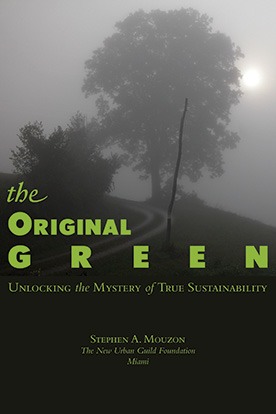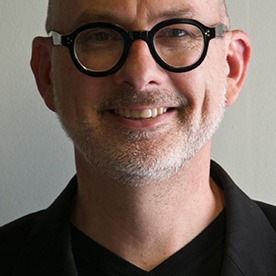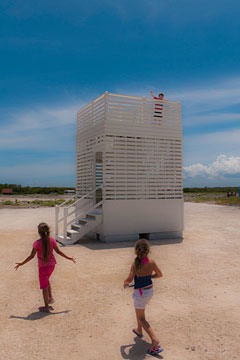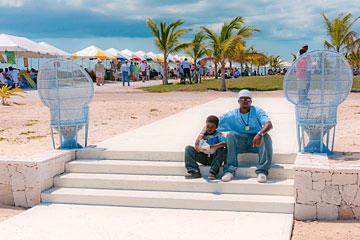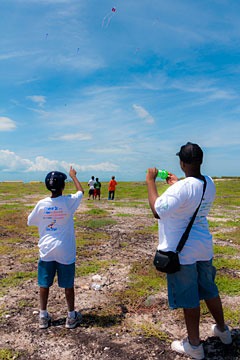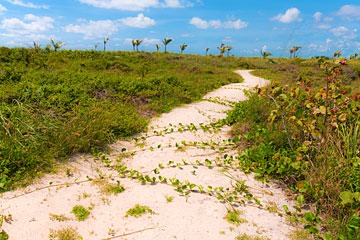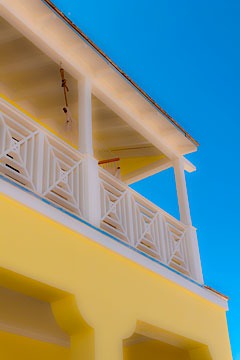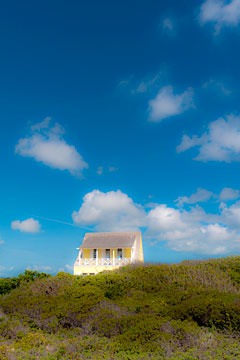search the Original Green Blog
Many New Urbanist places have for years sat more lightly on the land than most conventional developments. Several xeriscaping principles date all the way back to the beginning of Seaside, which was designed by DPZ and launched the entire New Urbanism movement. But Robert Davis, Town Founder of Seaside, didn’t mandate native species primarily for high-minded ideals, but rather to save the cost of an irrigation system.
This tradition has continued to this day in the work of many New Urbanists. For example, the Waters was re-planned after having originally been designed by others in a sprawling pattern. The original plan called for bulldozing a hill at the south end of what we redesigned as the Lucas Point hamlet. I told the Town Founder “let me save you the money of moving all that dirt; we’ll leave the hill, put a chapel on top, and line a street up with it to let the chapel terminate the vista.” Today, Chapel Hill is the most memorable view at the Waters, but the rationale for doing it that way was purely economic.
Schooner Bay, a new DPZ-designed town rising now on the eastern shore of Abaco in the Bahamas, probably illustrates Original Green principles more clearly and broadly than any other place built in our time. The Original Green is the sustainability that existed before the Thermostat Age, which also happens to be the era during which we developed really big bulldozers, dump trucks, and the like, allowing crushing environmental impacts that simply weren’t feasible before.
Orjan Lindroth, Town Founder of Schooner Bay, isn’t simply doing the right thing. Instead, he has also analyzed the cost savings of many of these low-impact measures. He calls it the Ecological Dividend. Conventional development is driven by two things: asset inflation and bank liquidity. Because of this, these developments are primarily marketing exercises, designed to create as much sales velocity as possible. The components of the Ecological Dividend don’t show up anywhere on a standard project pro-forma, but they can be immense, as we’ll see. Let’s examine the astounding Ecological Dividend that is accruing at Schooner Bay, keeping in mind that the same can be done elsewhere as well; it’s not specific to Schooner Bay.
Time
Many components of the Ecological Dividend would not be possible in a high-velocity development bent on building out in 2-3 years. High-speed development is almost always high-debt development as well. Development driven foremost by the ticking interest clock forces decisions not in the best interest of the place. Orjan has chosen not to burden Schooner Bay with debt that requires a schedule dictated by cash flow. The market, rather than the debt, determines the pace of development. This is the way that most of the Most-Loved Places were built.
Ultimately this is far more beneficial to both developer and the community. Homebuyers are not paying significant bank finance and interest costs in their land prices. These items can amount to 30% of the cost of a new development and these benefits are passed on directly to homeowners.
Diversity
Schooner Bay has, from the beginning, opened its doors to a diverse population of primarily Bahamians as well as foreigners across wide socio-economic strata. Because of this, it will not be subject to the generational risk faced by all single-purpose developments such as gated golf course subdivisions. Instead, the broad demographics of Schooner Bay will more closely mirror those of the Most-Loved Places of the Bahamas such as Harbour Island, Hope Town, and Man-of-War Cay. Building in this way should allow Schooner Bay to join that list of Most-Loved Places someday.
Landscaping
One clear beneficiary of this expanded timespan is the cost of landscaping. Schooner Bay runs an onsite nursery which provides all plant material for the town. Orjan plants heavily to create a subtropical paradise, but because the 200,000 trees he expects to plant will all be grown from seedlings in the nursery over several years rather than bought at a mature size from elsewhere, the savings should be approximately $38.8 million ($6/tree to propagate and grow vs. $200/tree to buy large.)
Earthwork

From the very beginning of Schooner Bay’s design, earthwork was always conceived as having multiple purposes. Every bucket of dirt that needed to be moved was slated to be used where it could create an asset. Not one load of dirt or sand has ever or will ever leave or enter Schooner Bay from elsewhere. Grading in a balanced way doesn’t just save on dump charges or borrow fees; it also saves large quantities of fuel necessary to haul the material back and forth. But the beginning of earthwork savings occurs when you decide to leave a lot of the material where it is already, like we did with Chapel Hill at the Waters. Conventional developments often mass-grade the site at the beginning for stormwater convenience and ease of construction. This also destroys all trees and other vegetation, eliminating all wildlife habitat as well. Savings on earthwork alone at Schooner Bay (existing plant material is counted below) should be about $24.4 million over conventional practices.
Forest

within the coppice
38 acres of forest are being preserved at Schooner Bay. A narrow band through the center of the forest is a parrot migration route preserved in DPZ’s original plan. But once sitework surveying began and Orjan saw the beauty of the coppice, he asked DPZ to dramatically expand the preserved area. Galina Tachieva, DPZ's Project Director and author of the Sprawl Repair Manual, marveled that a Town Founder would preserve so much green space because typical developers want to cram every available sliver of land with as many lots as they can sell. Planting a coppice like this one would cost at least $1 million/acre; preserving the whole thing cost only $200,000, for a net Ecological Dividend of $37.8 million.
Dune

front dune at Schooner Bay
Years ago, when Seaside went through its first major hurricane, it came out virtually unscathed, while there was major devastation for miles on either side. Hurricane experts from all over flocked to Seaside, and for several months afterwards, news reports referred to it as the Seaside Miracle. Analysis eventually showed that while Seaside’s higher structural standards helped, the biggest single factor was the decision to build behind the dune instead of on the dune. Orjan took this to heart, planting the first dune with thousands of native dune plants so their collective root systems will reinforce it. He then built a second dune a few dozen yards behind it, further strengthening the shoreline and providing a platform for houses just behind the second dune. The second dune turned lower-value lots with no view into oceanfront lots by elevating them, and was built using the sand spoil from the harbour excavation. It turns out that because the dune adjoins the harbour, the second dune’s location was actually the closest place the sand spoil could have been used, reducing hauling to a minimum. Building a dune in conventional fashion by hauling sand onto the site would have cost about $7.5 million, but using harbour spoils costs only $200,000, for a dividend of $7.3 million.
Interestingly, the eye of Hurricane Irene crossed over Schooner Bay at her strongest point in the fall of 2011, with winds of 125-130 miles per hour. Yet in spite of the fact that most building components (even the windows) are built on-site, not a single pane of glass was broken! Here's the full story of the Schooner Bay Miracle.
Harbour
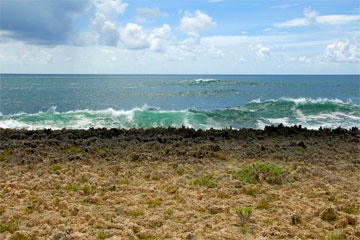
rugged rock shoreline protects the back side of the whale-tail
of the harbour
The Harbour at Schooner Bay was the source of many feet of topsoil that had eroded over the centuries from the higher rocky land to the hollow that became the harbour. Returning the topsoil to the higher land made it more valuable, especially because Schooner Bay is doing so many things to become a Nourishable Place. Building that much topsoil for gardens would take each homeowner several years of work. The harbour itself contributes food as well, as it will be home to a small fishing fleet, making Schooner Bay an authentic fishing village. It should be noted that the natural whale-tail shape of the shoreline at this point shelters the harbour to an unusual degree, making Schooner Bay the best site for a harbour for many miles around. The dividend created by all the benefits of the harbour is estimated at $20 million.
Community Cistern
Normally, water is stored in steel tanks with pressure equipment, all of which is subject to corrosion and normal wear and tear. Orjan took an alternative route, building a 2-acre sand tank on the ridge 60 feet above the town center and allowing the water to gravity-flow to its destinations. Net savings are $2 million, plus all the avoided maintenance in the future. Also, material excavated to create the cistern was used to make building pads. As elsewhere, everything on the site has at least a double use, in good Cradle-to-Cradle fashion.
Eco Machine
Sewer treatment in a remote location is usually expensive, as you have to create your own sewer treatment plant. Normally, these are large, smelly, undesirable things as well. The Eco Machine lets nature do the job instead, digesting sewage below ground level in what appears to be nothing more than a long swale or rain garden planted with a variety of plants designed for each step of the digestion process. The Eco Machine trades odor for beauty, and saves $2.5 million.
Smaller & Smarter Homes
Schooner Bay champions the idea of building smaller and smarter as well as any place being built today. They are literally satisfying the same customers in half the space they might otherwise have built. So while other oceanfront developments in the Bahamas might average $800,000 in construction cost per house, Schooner Bay is doing enough clever things that they are averaging only $400,000 per house... and those houses are extremely well-built. At 500 homes, that’s a staggering $200,000,000 difference in construction cost.
But as stunning as this is, it’s only half the story. The other half is the fact that Schooner Bay will have a completely unheard-of range of 40 to 1 from most expensive to least expensive homes... or from around $4 million to just under $100,000. In short, it will feel like other great Bahamian towns like Dunmore Town, full of a complete range of Bahamian culture, rather than terminally boring subdivisions where everyone is wealthy. And yes, at this price range, most of the residents will be Bahamians instead of foreigners.
Living Traditions

model pavilion was built to illustrate construction patterns people
have not considered building in a long time in the Bahamas, but
which are eminently suited to the region
Orjan and a group of fellow Bahamians commissioned A Living Tradition [Architecture of the Bahamas] several years ago; the book has since won a CNU Charter Award. The title isn’t marketing fluff; rather, it makes note of the core aspiration of the book: to start a new living tradition of Bahamian architecture based on patterns that make the most sense for regional conditions, climate, and culture. I have tested many ideas over the years meant to contribute to restarting living traditions, and what I have found is that without a living tradition, builders will price standard suburban sprawl details as “standard price,” whereas better details that make more sense and even use less labor and materials get “custom pricing.” But once a tradition begins to spring to life in the builder community, the equation inverts: when they now know why they’re doing the better details, those better details get “standard pricing” and the bad details they don’t want to do anymore get “custom pricing.” It’s not yet clear what the savings will be from the traditions beginning to live at Schooner Bay, but it will doubtlessly be somewhere in the tens of millions of dollars.
Capital Cost Dividend
Just in case you’re not keeping track, the total Ecological Dividend of building the Original Green way totals $332.8 million. And that doesn’t even consider the other benefits of time, nor the value of living traditions. But there are operating cost savings as well:
Electricity & Geothermal Cooling
Building smaller and smarter creates several dividends beyond the initial construction cost. Smaller houses daylight better and also cross-ventilate better because each room is likely to have more exterior walls. This reduces both cooling loads and lighting loads, and a reduced lighting load reduces the need for cooling even further. So you’re not only lighting and cooling less space, but you’re also doing it more efficiently... which is a really good thing, because electricity is expensive in the Bahamas.
Schooner Bay cools geothermally, which will save up to 50% versus standard heat pumps. The savings below are calculated assuming everyone shuts the houses up and runs the heat pumps all the time. But geothermal cooling has a huge hidden benefit: because the units dump heat into water rather than into air, you don’t need condenser units sitting just outside, buzzing and blowing hot air most of the time. A courtyard with a couple condenser units is uninhabitable when they’re running because they’re so annoying, and they’re blowing hot air on you if you’re sitting nearby. But a quiet (and cooler) courtyard entices you outdoors, where you get acclimated to the Bahamas’ balmy climate, and therefore need less air conditioning when you return indoors.
You might actually find that you need air conditioning only on the hottest days, and if so, you’ll discover that there is no equipment so efficient as a machine that is off. Discover this, and you’ll find a way of saving far more than the 50% savings over standard heat pumps, while enjoying your outdoor rooms much more than you otherwise would. Total electricity savings for cooling and everything else should be about $2 million per year on the roughly 500 houses that will populate Schooner Bay at full build-out.
Water Supply & Reuse
Water supply is very expensive in the Bahamas as well, and more subject to inflation than most commodities as fresh water is quite limited. Schooner Bay captures rainwater and treats it rather than buying it from elsewhere. Homes and other buildings at Schooner Bay reuse greywater for flushing toilets and irrigating gardens, reducing the need for treated water by about half. The water supply and reuse dividend should be about $2.5 million per year.
Waste Water Treatment
When you reuse water, and use less water to begin with, you don’t have to treat as much waste water. The wastewater treatment dividend is estimated to be $1.44 million per year.
Food
Schooner Bay will not only be a true fishing village, but will be ringed by acres of organic gardens on the landward side. Farmed in a bio-intensive manner, it may be possible to feed the entire town with food raised in the gardens and fished from the sea. There are many benefits to local organic food, including the facts that it is both healthier and tastier, that it doesn’t require countless gallons of oil to transport from faraway fields in foreign lands, and that you know your farmer. Yes, that’s correct... it’s likely that the farmer will provide housing for the farm workers at Schooner Bay or immediately adjacent. But how do you put a value on that? Would eating that way be worth a difference of a dollar a meal to you? If so, then that’s a food dividend of $1.5 million per year.
Transportation & the Local Economy
Orjan is working harder than any New Urbanist developer I have ever worked with to create a local economy at Schooner Bay. The benefits of being able to walk to shops and services are obvious, but how do you do it in a way that survives the early years, when there aren’t enough residents to support those businesses? Engagement with the locals living around Schooner Bay is essential to develop a customer base outside Schooner Bay... and these people are very sparsely served now, with most goods and services over 25 miles away in Marsh Harbour. Schooner Bay has already begun reaching out to its neighbors with the Schooner SpringFest held recently, featuring footraces, bike races, and a day of food, music, and general good times attended by several hundred Abacoans.
There are other ways of making shops self-sustaining early on, and they center around two questions: “How can you reduce the costs of operation?” and “Who can open a shop without needing a full income?” The principles of building smaller and smarter apply as well to shops as to homes, of course. Tiny shops have a long history in the Bahamas, where small island populations seldom supported large operations, so they should fit in naturally. Two potential types of shopkeepers come to mind when answering the second question: Retirees looking for a second career are the most likely candidates, but it’s also possible that some professionals who can live at Schooner Bay and work remotely might also run a coffee shop or the like on the side.
In either case, expect to be able to go to Schooner Bay and not drive for days in the relatively near future. The goal is to reduce driving by 80%, which at full build-out would save $4.8 million per year. This figure, of course, doesn’t even take into account the other economic and social benefits of a local economy that allows people to make a living where they’re living.
Operating Cost Dividend

The total dividend of the things we’ve counted above is $12.24 million per year. But to really see what it means, you have to ask “what can we buy now that we don’t have to spend that money on operating expenses?” Using a capitalization rate of 5%, this computes to an operating cost dividend of $244.8 million!
In other words, the yearly operating cost savings are so large that a true market-based pro-forma that reflects the Ecological Dividend would look far different from a standard development pro-forma. Simply put, the Ecological Dividend is a tool that enhances all aspects of development. Those who want to build Most-Loved Places in a sustainable way should choose this lens in order to see the real impacts of their community-building choices.
~Steve Mouzon
This article was first published in New Urban News in October 2011.
Another Note: This post is part of an extended BlogOff on Return on Investment (RoI) of municipal spending. These are the posts in the BlogOff so far… please join us!
2/24/12 - Cheapways, Steve Mouzon
2/20/12 - The Speed Burden, Steve Mouzon
1/27/12 - On the Street: The DNA of place and the ROI of movement, Hazel Borys
